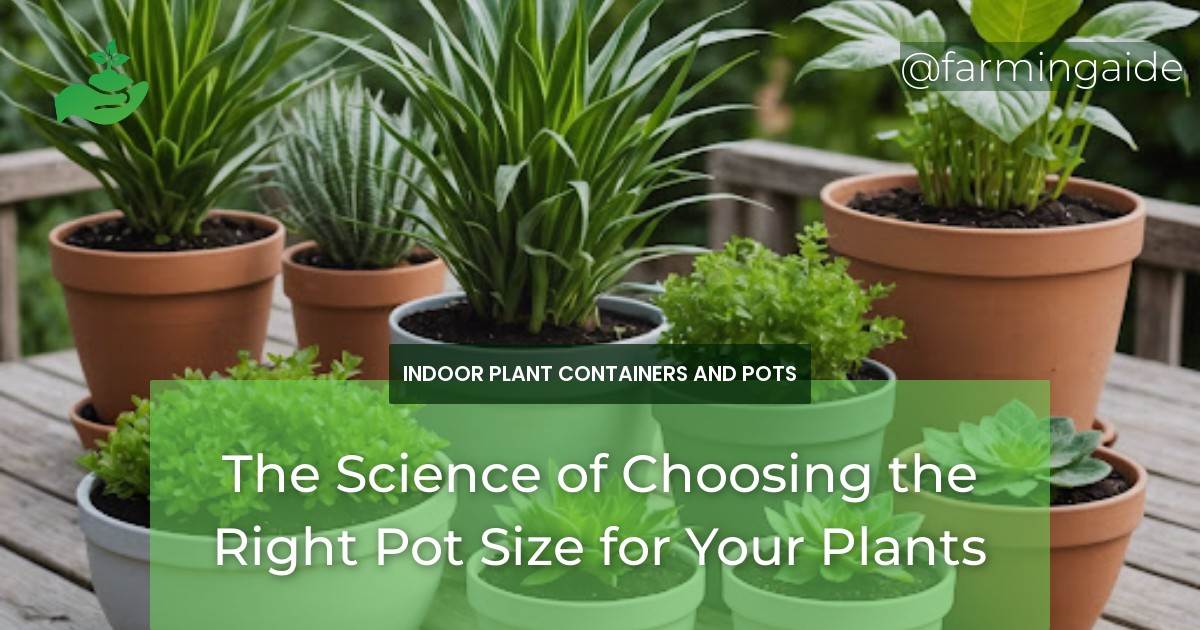When it comes to indoor gardening, one of the most crucial decisions you’ll make is choosing the right pot size for your plants. While it may seem like a minor detail, the pot size can significantly impact your plant’s growth, health, and overall well-being. In this article, we’ll delve into the science of choosing the right pot size for your plants, exploring the key factors to consider, common mistakes to avoid, and providing a step-by-step guide to repotting.
Key Takeaways
- Pot size affects root development and nutrient absorption.
- Choosing the right pot size depends on plant species, growth rate, and pot material.
- Signs of needing a bigger pot include slow growth, yellowing leaves, and waterlogged soil.
- Repotting at the right time can boost plant growth and health.
- Common mistakes include overpotting and underestimating plant growth potential.
Understanding Plant Growth and Pot Size
Plant growth is a complex process influenced by various factors, including genetics, environment, and nutrition. When it comes to pot size, the relationship between the plant’s roots and the pot’s volume is critical. A pot that’s too small can restrict root growth, leading to stunted plants, while a pot that’s too large can cause the soil to become waterlogged, reducing oxygen availability.
To understand the ideal pot size, it’s essential to consider the plant’s growth rate, root system, and nutrient requirements. For example, fast-growing plants like tomatoes and cucumbers require more space and nutrients, while slow-growing plants like succulents and cacti can thrive in smaller pots.
The Role of Pot Size in Root Development
Root development is crucial for plant growth, and pot size plays a significant role in this process. A pot that’s too small can limit root growth, reducing the plant’s ability to absorb nutrients and water. On the other hand, a pot that’s too large can cause the roots to become too spread out, reducing their effectiveness.
Research has shown that plants grown in larger pots tend to have more extensive root systems, which can lead to improved plant growth and increased yields.
How Pot Size Affects Nutrient Absorption
Pot size also affects nutrient absorption, as the soil’s nutrient availability is influenced by the pot’s volume. A pot that’s too small can lead to nutrient deficiencies, while a pot that’s too large can cause nutrient waste. By choosing the right pot size, you can ensure your plant receives the necessary nutrients for optimal growth.
A study published in the Journal of Plant Nutrition found that plants grown in pots with optimal sizes had improved nutrient uptake and utilization compared to those in undersized pots.
Factors to Consider When Selecting a Pot
When selecting a pot, it’s essential to consider several factors, including plant species, growth rate, pot material, and soil type.
ALSO READ
Plant Species and Their Pot Size Requirements
Different plant species have unique pot size requirements. For example:
| Plant Species | Pot Size Requirement |
|---|---|
| Tomatoes | At least 5-gallon pot |
| Cucumbers | At least 3-gallon pot |
| Succulents | Small to medium-sized pots (1-2 gallons) |
| Cacti | Small pots (1-2 gallons) |
The Impact of Pot Material on Plant Health
The material used to make the pot can also impact plant health. For example, clay pots tend to dry out faster than plastic pots, which can affect soil moisture levels. Ceramic pots, on the other hand, can retain heat, which can be beneficial for warm-season crops.
When choosing a pot material, consider factors like drainage, insulation, and durability to ensure optimal plant growth.
Signs Your Plant Needs a Bigger Pot
If you’re unsure whether your plant needs a bigger pot, look for these signs:
ALSO READ
Visible Indicators of Root Bound Plants
If your plant is root-bound, you may notice:
- Slow growth or stunted plants
- Yellowing or dropping leaves
- Waterlogged soil or frequent watering
Symptoms of Inadequate Pot Size
In addition to visible indicators, inadequate pot size can cause:
- Reduced plant yields or productivity
- Poor soil structure or waterlogging
- Increased risk of pests and diseases
Step-by-Step Guide to Repotting
Repotting can be a daunting task, but with the right steps, you can ensure a successful transition for your plant.
When and How to Repot Your Plants
Repot your plant when you notice signs of root bound or inadequate pot size. Choose a pot that’s only 1-2 sizes larger than the current one to prevent overwhelming the roots.
Follow these steps for successful repotting:
- Prepare the new pot by adding a layer of fresh potting soil.
- Gently remove the plant from its current pot, taking care not to damage the roots.
- Inspect the roots, pruning any dead or damaged roots.
- Place the plant in the new pot, adding fresh potting soil as needed.
Choosing the Right Soil for Repotting
When repotting, it’s essential to choose the right soil for your plant. Consider factors like:
- Soil pH and nutrient levels
- Drainage and aeration
- Organic matter content
Common Mistakes to Avoid When Choosing Pot Size
Avoid these common mistakes to ensure optimal plant growth:
Overpotting and Its Consequences
Overpotting can lead to:
- Waterlogged soil and root rot
- Reduced plant growth and yields
- Increased risk of pests and diseases
Underestimating Plant Growth Potential
Underestimating plant growth potential can lead to:
- Root bound plants
- Reduced plant growth and yields
- Increased risk of pests and diseases
Conclusion: The Long-Term Benefits of Proper Pot Sizing
Choosing the right pot size is crucial for optimal plant growth, health, and productivity. By understanding the factors that influence pot size selection, you can ensure your plants receive the necessary nutrients and care for thriving growth. Remember to avoid common mistakes, and don’t hesitate to repot your plant when necessary. With proper pot sizing, you can enjoy a bountiful harvest and a thriving indoor garden.


